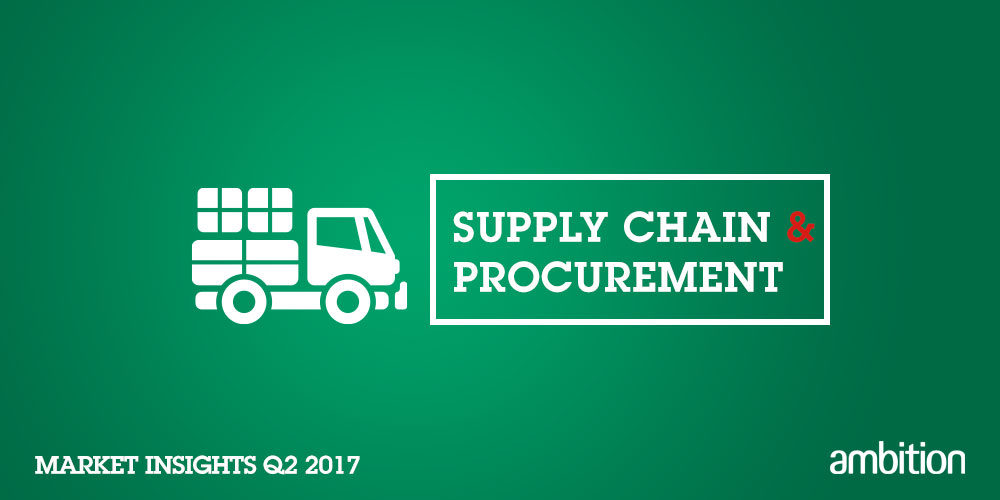Please beware of recruitment scams that are currently targeting jobseekers. Click here for further advice.

Supply Chain & Procurement Market Insights Q2 2017
As companies looked into implementing their hiring and restructuring plans for the new year, the first few months of 2017 saw a gradual upturn in talent demand within Supply Chain & Procurement for Singapore and the wider Southeast Asia region.
In Q1 2017, while there was still a continuing outflow of manufacturing facilities to more cost-effective locations across Southeast Asia, there has been a more robust talent demand in Professional & Financial Services, Healthcare and e-Commerce sectors.
Logistics and e-Commerce service providers continued to compete for talent with expertise in cross-border freight, warehousing and last mile delivery. Operational workers such as warehouse staff and drivers continue to be in short supply, with businesses suffering from high turnover in these areas.
We have seen organisations face challenges in attracting quality hires, whilst retaining the best people in the business continues to be a priority. Organisations today have been facing intense competition for talent, with the advent of start-ups as well as established MNCs launching in Singapore to serve the Southeast Asia market.
Businesses covet exceptional talent in Supply Chain & Procurement
Professionals with deep knowledge in Supply & Demand Planning, Inventory Management and Forecasting continued to be in high demand across FMCG and Pharmaceutical industries. Often, these Supply Chain pros were drawn towards companies with robust ERP tools and processes.
We observed that professionals with Project Management and Implementation experience in 3PL and 4PL industries remained highly sought after. For these job seekers, differentiating skills such as excellent stakeholder management and client management have placed them at an advantage.
Additionally, there was a continued demand for Indirect Procurement professionals with an extensive experience in specific commodities. We saw a trend where companies specifically look for talent with the ability to transform the procurement function from being mere transactional to being value-adding and strategic.
Positive hiring outlook for Q2 2017
Moving into Q2 2017, we expect to see an optimistic job market for Supply Chain & Procurement, with many professionals adopting an open mindset to explore new opportunities.
We expect to see the local talent pool remaining strong in this space, with limited requirements for foreign talent except for strategic leadership positions. Professionals with regional exposure and cross-border Supply Chain experience will continue to be in demand throughout the months ahead.
Supply Chain & Procurement
Salary Report for Q2 2017*
Supply Chain & Logistics |
|
|
|
Job title | Years of experience | Singapore | Malaysia |
|
| Annual salary range (S$) | Annual salary range (RM$) |
Supply Chain Management | |||
Head of Supply Chain | 18+ | 220K–300K | 300K–500K |
Regional Supply Chain Director / VP | 15+ | 150K–180K | 250K–400K |
Supply Chain Director / VP | 12+ | 120K–160K | 200K–280K |
Supply Chain Manager | 8–12 | 90K–120K | 150K–220K |
Assistant Supply Chain Manager | 6–8 | 60K–100K | 100K–180K |
Senior Supply / Demand Planner | 4–6 | 50K–80K | 80K–140K |
Supply / Demand Planner | 3–5 | 55K–75K | 80K–120K |
Logistics / Warehouse / Operations | |||
Head of Logistics / Warehouse Operations | 18+ | 180K–240K | 260K–420K |
Regional Director / VP | 15+ | 160K–200K | 220K–360K |
Director / VP | 12+ | 140K–180K | 240K–300K |
Regional Manager | 7–10 | 100K–140K | 180K–240K |
Manager | 5–8 | 60K–80K | 95K–130K |
Assistant Manager | 3–5 | 50K–70K | 80K–120K |
Procurement / Purchasing | |||
Head of Procurement | 15+ | 220K–300K | 300K–500K |
Director / VP | 12+ | 150K–260K | 250K–280K |
Senior Manager | 10+ | 100K–180K | 180K–400K |
Manager | 8–10 | 80K–130K | 120K–200K |
Assistant Manager | 5–7 | 60K–80K | 95K–130K |
*Notes about salary table:
Titles and levels vary from organisation to organisation.
The salary ranges given are only approximate guides. For tailored salary advice, please contact us directly.
12-month base salaries are assumed.
All other benefits and bonuses are in addition to these figures.
Bonus ranges can vary significantly from company to company and will be influenced by market conditions, business and individual performances. Bonus ranges from 1 month at the low end to 100%+ at the upper.
Holiday entitlements range from 12–25 days with senior executives not usually receiving less than 18 days. Less than 15 is very rare and 20 days is becoming the norm.
Healthcare policies are standard.
Pension plans vary with some companies offering greater than the standard contribution. Top up schemes can increase employer contribution levels as much as 15– 20% of the base salary for senior executives.
![[Blog] Singapore Tech Hiring Trends In 2024](https://image-assets.eu-2.volcanic.cloud/api/v1/assets/images/8a5125ce4126182db0f67154a354982f?size=480x500%3E)
![[Blog] Ww A Soh Siew Choo](https://image-assets.eu-2.volcanic.cloud/api/v1/assets/images/169d18cccded8fc32b206a310a4e8702?size=480x500%3E)
![[Blog] Top 10 Q1 Sg](https://image-assets.eu-2.volcanic.cloud/api/v1/assets/images/e2e074b41ac9c899e74285046f549373?size=480x500%3E)
![[Blog] 2019 Movember](https://image-assets.eu-2.volcanic.cloud/api/v1/assets/images/da8e63e6ced04720f6007f26088987ab?size=480x500%3E)

![[Blog] Iwd Nicky](https://image-assets.eu-2.volcanic.cloud/api/v1/assets/images/1072f5404fc27cdfa5e58983c182ae3a?size=480x500%3E)

